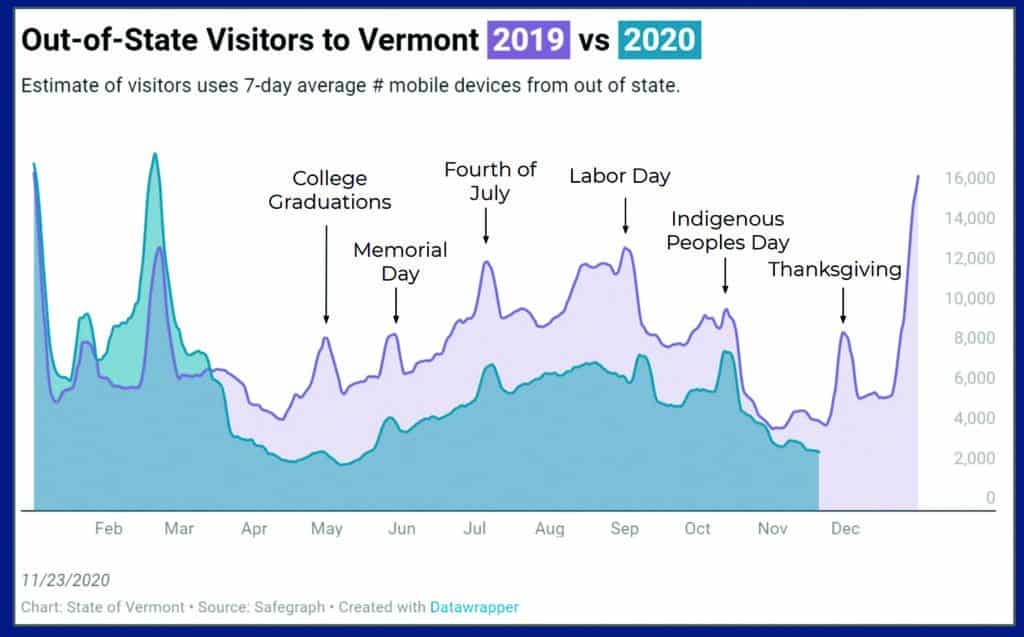Adherence to prohibition on gatherings is critical to prevent worst-case scenario
By Polly Mikula
In the first three weeks of November, Vermont has added more Covid cases than in the first five months of the pandemic combined (March-July) — 40% of the state’s total cases.
“With the amount of virus in our communities right now, even your trusted friends and households are at much greater risks,” Governor Phil Scott said at the news conference Tuesday, Nov. 24. “That’s why we placed a
restriction on all gathering and require quarantine for all non-essential travel.”
Friends and families that Vermonters once trusted could be infected and may not know they have the virus, Scott explained.
“Insidiously, 40% of the spread of Covid-19 has been through asymptomatic carriers,” added Dr. Mark Levine, state health commissioner.
Gov. Scott first announced a prohibition on social and multi-household gatherings on Nov. 13, pointing to the fact that 71% of Vermont cases were traced back to small social gatherings.
“Almost every single case here in Vermont has been traced back to a social gathering with small groups of friends and family,” Scott said Tuesday. “Specifically, the Washington County outbreak, has been almost exclusively a result of this type of behavior.”
Washington County now has the 10th highest concentration of Covid in the northeast, Commissioner of Financial Regulation Michael Pieciak said, Tuesday.
“If you went to a social gathering in Washington County this past week, there’d be a 25-50% risk that you’d have been exposed to Covid and become a positive case,” Scott explained. “It’d hope that’d be enough to deter most people.”
Thanksgiving spike?
The rise in cases in November has yet to account for a projected Thanksgiving spike, which worries state officials. Pieciak said that the nation has seen clear spikes after every major holiday during the pandemic, including Memorial Day, Fourth of July, Labor Day and Halloween. While Vermont was generally spared spikes after summer holidays, colder weather has driven gatherings inside and “the state did experience dramatic increases in the weeks following Halloween, and that continues to impact us today,” Pieciak said.
“Now Thanksgiving is a mere two days away, a holiday that unfortunately brings together our two greatest concerns at the moment: Travel and indoor gatherings,” he continued.
Pieciak noted that over Thanksgiving weekend last year Vermont received visitors from every state in the country. “Over 100,000 people are estimated to have visited Vermont during last Thanksgiving weekend. With the number just slightly smaller of Vermonters visiting other places around the region and around the country… as you can see travel was quite broad and extensive, if we see travel like that this year it will be quite alarming.”
“We continue to believe that Vermonters will respond to the state guidelines at a rate much higher than the rest of the country but, unfortunately, national surveys indicate that 38% of individuals are still planning to have holiday gatherings 10 or more people,” Pieciak reported. “If this were true in Vermont and 38% of people have large gatherings with people outside their immediate household and travel, then we’d see a significant increase in cases… in fact, we estimate that we’d see an increase of an additional 3,200-3,800 cases simply as a result of Thanksgiving gatherings and this is on top of normal case growth… that would result in 40-50 new hospitalizations… it would allow cases to get into our schools and disrupt learning, it would get into our workplaces and our hospitals and long-term care facilities.”
“We need Vermonters to respond to the state guidance, so that we don’t realize this worst case scenario,” Pieciak concluded.
A Thanksgiving spike won’t be detectable until a week or two after the holiday.
“I hope everyone hears these messages and will change their plans and stay home,” Scott said.
Scott said that in light of the upcoming Thanksgiving holiday and the expectation for non-perfect compliance, K-12 school have asked for the state for guidance to keep their schools and communities safe.
Beginning after break, school officials will ask students or parents if they were part of mulit-family gatherings as part of the daily health check, Scott said. “If the answer is yes, then they will need to transition to remote learning for 14 days or 7 and a negative test, just like if they had traveled out of state.”
Additionally, Scott said, “we will be postponing school sports. Like rec sports, these are paused until further notice.”
K-12 winter sports had been scheduled to start Nov. 30.
“I’m very hopeful that the measures we’ve put into place will have a positive impact. We don’t want to close down any more of the economy than we have… we don’t want to go there again,” Scott said in summary, Tuesday. “The data and science tells us that it’s the small gatherings that is driving the uptick right now in Vermont, not the schools or the restaurants or retail operations, it’s about recreational events and social gatherings with friends, so if we can prevent that from happening we won’t have to take any further measures,” Scott said.
“The vast majority of Vermonters are doing the right thing,” Scott said. “If we can just do the right thing to protect ourselves and our fellow Vermonters, if we can just get through the rest of this year, there is very positive news regarding a vaccine, and hopefully we’ll be able to get back to some normalcy soon.”





